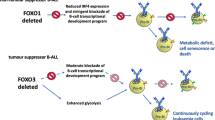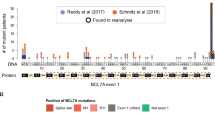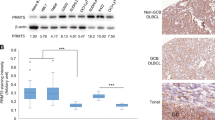Abstract
Abnormalities of several cell-cycle regulatory genes including cyclin D1, p16CDKN2 and p15CDKN2B have been described in B cell non-Hodgkin’s lymphoma (B-NHL). We describe a new B-NHL cell line (Granta 519), with concurrent abnormalities of the cyclin D1, p16CDKN2 and p15CDKN2B genes. An independent clinical case of mantle cell NHL (Mc-NHL) with concomitant overexpression of cyclin D1, and deletion of the p16CDKN2 gene was also identified, suggesting that this combination of oncogenic aberration is a pathophysiologic contribution to a subset of NHL cases. More in-depth functional studies of this concept were facilitated by the availability of the cell line Granta 519 which was derived from a case of high-grade NHL and has a mature B cell immunophenotype. Cytogenetic analysis identified translocation t(11;14)(q13;q32) and complex rearrangements involving chromosomes 9p22, 13p21, 17p11, and 18q21. Molecular analysis identified overexpression of cyclin D1 mRNA and biallelic deletion of the p16CDKN2 and p15CDKN2B genes. To elucidate the effect of these genetic abnormalities on the G1 control of Granta 519 cells, the level and function of the major components of the cyclinD/retinoblastoma (RB) pathway were investigated. Cyclin D1 was dominant among the D-type cyclins, formed abundant complexes with cyclin-dependent kinase (Cdk) Cdk4 rather than Cdk6, and the immunoprecipitated cyclin D1/Cdk4 holoenzyme was active as a pRB kinase. Electroporation of wild-type p16CDKN2 arrested the Granta 519 cells in G1, consistent with the p16CDKN2 loss as a biologically relevant event during multistep evolution of the tumor, and with the expression of functional pRB. Direct cooperation of these distinct abnormalities to cell-cycle deregulation in NHL cells was suggested by G1 acceleration upon inducible overexpression of cyclin D1 in a control breast cancer cell line lacking p16CDKN2 , an effect which could be prevented by ectopic expression of p16CDKN2. Taken together, these data suggest that concurrent overexpression of cyclin D1 and functional elimination of p16CDKN2 and p15CDKN2B may characterize certain cases of mantle cell NHL, and that cooperation of the abnormalities is likely to provide a growth advantage of the tumour cells through more efficient inactivation of the RB tumor suppressor. Further clinicopathologic studies of this possibility are warranted.
This is a preview of subscription content, access via your institution
Access options
Subscribe to this journal
Receive 12 print issues and online access
$259.00 per year
only $21.58 per issue
Buy this article
- Purchase on Springer Link
- Instant access to full article PDF
Prices may be subject to local taxes which are calculated during checkout
Similar content being viewed by others
Author information
Authors and Affiliations
Rights and permissions
About this article
Cite this article
Jadayel, D., Lukas, J., Nacheva, E. et al. Potential role for concurrent abnormalities of the cyclin D1, p16CDKN2 and p15CDKN2B genes in certain B cell non-Hodgkin’s lymphomas. Functional studies in a cell line (Granta 519). Leukemia 11, 64–72 (1997). https://doi.org/10.1038/sj.leu.2400555
Received:
Accepted:
Issue Date:
DOI: https://doi.org/10.1038/sj.leu.2400555
Keywords
This article is cited by
-
Identification and characterization of OSTL (RNF217) encoding a RING-IBR-RING protein adjacent to a translocation breakpoint involving ETV6 in childhood ALL
Scientific Reports (2014)
-
Measles Virus Entry Through the Signaling Lymphocyte Activation Molecule Governs Efficacy of Mantle Cell Lymphoma Radiovirotherapy
Molecular Therapy (2013)
-
Antiproliferative and proapoptotic activity of GUT-70 mediated through potent inhibition of Hsp90 in mantle cell lymphoma
British Journal of Cancer (2011)
-
Mantle cell lymphoma salvage regimen: synergy between a reprogrammed oncolytic virus and two chemotherapeutics
Gene Therapy (2010)
-
Expression of sphingosine-1-phosphate receptor 1 in mantle cell lymphoma
Modern Pathology (2010)



